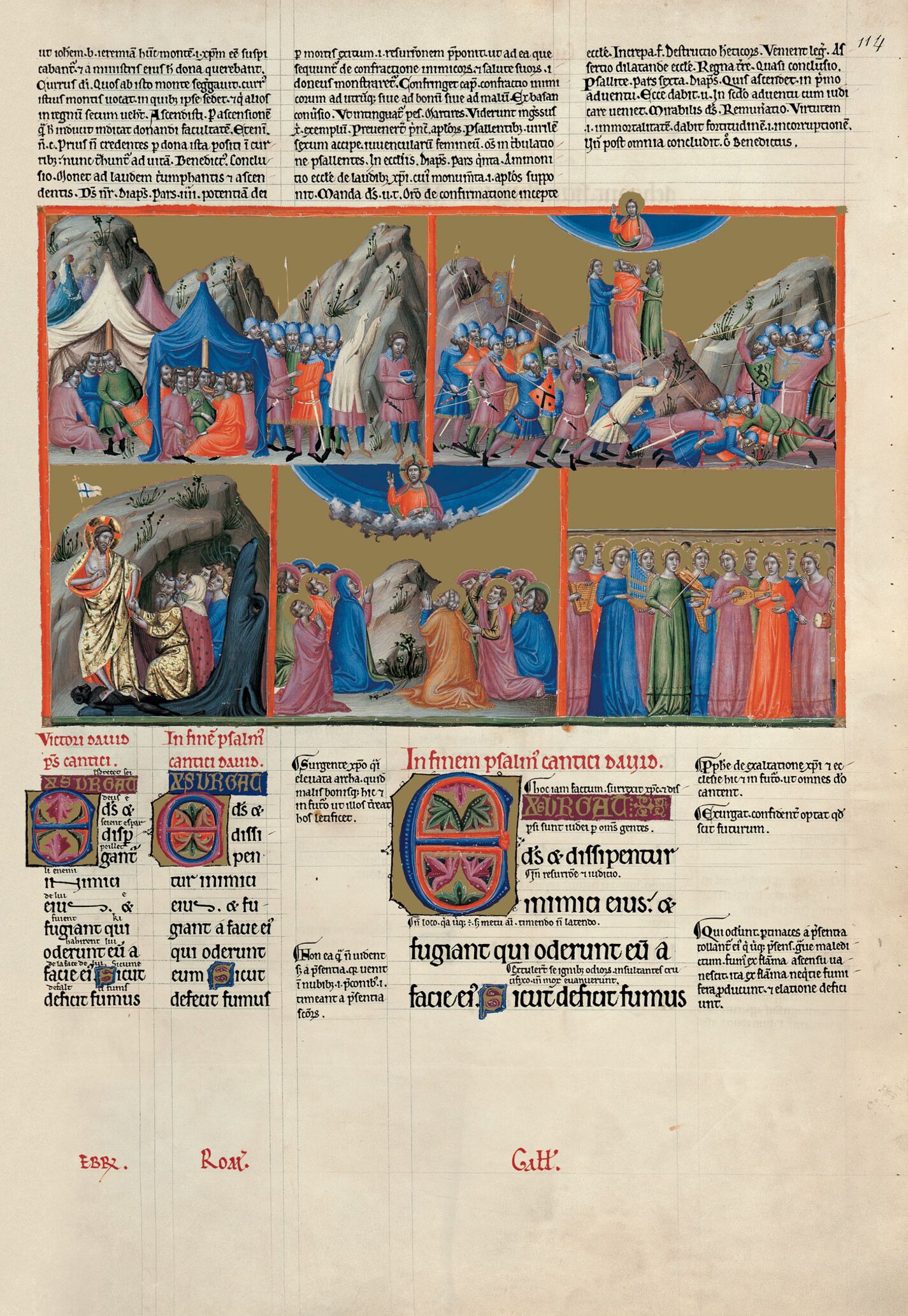Depicted in the upper band are Old Testament themes. Reference is made to Joshua’s camp and its need for provisions, particularly the water supplied to the army thanks to Moses’ pleas. The happening is reflected in the images of recipients containing water and the ritual of drinking one after another inside the tents prior to gathering before the battle (Ex 25: 22-27, particularly 26-27). The following scene reflects the battle and victory of the sons of Israel, bearing a pendant with a griffon and coat of arms with diagonal, dotted stripes, stars and rhombuses, above the followers of Amalech, carrying shields with a rampant lion and an eye-catching bird with outstretched wings. Whilst the Amalecites bleed and die in a heap on the right side, reference is made in the middle on a promontory to the intervention of Moses that was so important in Joshua’s victory (v. 9, Terra mota est, etenim coeli distillaverunt à facie Dei Sinaï, à facie Dei Israël // The earth was moved, and the heavens dropped at the presence of the God of Sina, at the presence of the God of Israel). We know that the patriarch, with the help of Aaron and Hur who were entrusted with holding his arms up, addressed God with his hands and prayers until sunset, when God answered his plea and, as depicted in the miniature, blessed his people by proclaiming the triumph over the Amalech’s followers (Ex 17: 8-16), an obvious way of exemplifying the divine power mentioned in the psalm (v. 22, Veruntamen Deus confringet capita inimicorum suorum: verticem capilli perambulantium in delictis suis // But God shall break the heads of his enemies: the hairy crown of them that walk on in their sins).
Psalm 67 has been traditionally linked to the Ascension of Christ, as shown in St Jerome’s writings (Breviarium..., 1077 and Tractatus... 102-106, Patr. Lat., Suplementum II, Paris, 1960), hence this episode could not fail to appear in Bassa’s illustrations. Unusually, the Ascension into Heaven here is accompanied by the Descent into Hell (Anastasis) and a third picture of an outstanding choir of what might be angel musicians. The descensus ad Inferos evoked in the psalm (v. 7: “Deus qui inhabitare facit unius moris in domo: Qui educit vinctos in fortitudine, similiter eos, qui exasperant, qui habitant in sepulchris. // God who maketh men of one manner to dwell in a house: Who bringeth out them that were bound in strength; in like manner them that provoke, that dwell in sepulchres) in an allusion to the divine capacity to redeem sin, to provide an escape from death, to return the fallen from the depths of the sea and to build the road to humanity’s salvation (v. 20-23), must be compared with the same scene in the Morgan Polytypch, which again features the zoomorphic mouth albeit with certain differences. In the panel, all the patriarchs are dressed in white, unlike in the codex where Christ, Adam, Eve and king David are all portrayed in different garb. The attention paid to the jaws of the hellish beast recalls other folios in the Psalter that resort to this motif (ff. 100 and 109v). The portrayal of this animal as the entrance to hell is usually avoided and did not prevail in Byzantine and Italian works, the preferred representation being the entrance to a cave in rocks, with or without the addition of other architectonic motifs. Christ, armed with a spear and his body scarred by his martyrdom upon the cross, treads on the male figure of the conquered demon depicted here with the twisted horns of the great ram often used to represent it.
Most of the elements in the miniature, linked to the Old and New Testaments, finally acquire a festive dimension that implies triumph over the enemy, over death or over evil. This requires an effort that could be celebrated. The concert given by apterous angels or wingless, young musicians linking heaven to earth comes, therefore, as no surprise (v. 26, Praevenerunt principes conjuncti psalentibus, in medio juvencularum tympanistriarum. // Princes went before joined with singers, in the midst of young damsels playing on timbrels). I do not overlook, in this respect, that the psalm refers to the gifts given to the Lord by the Wise Men (v. 30, A templo tuo in Jerusalem, tibi offerent reges munera. // From thy temple in Jerusalem, kings shall offer presents to thee) and the earthly kingdoms who praise and play psalms before him (v. 33, Regna terrae, cantate Deo: psallite Domino: pasillite Deo, // Sing to God, ye kingdoms of the earth: sing ye to the Lord: Sing ye to God). The young men play a psaltery, portable organ, viola, triangular psaltery, lute, cymbals, flute and tabor, and sing canticles to the God who conquers death and ascends to heaven after descending into hell and overcoming the evil embodied by the devil. The Ascension (v. 34, Qui ascendit super coelum coeli, ad Orientem. // Who mounteth above the heaven of heavens, to the east. Behold he will give to his voice the voice of power; and S. E, Hyeronimus, Breviarium..., 1081) concludes the tale (v. 35, Date gloriam Deo super Isräel, magnificentia ejus, et virtus ejus in nubibus. // Give ye glory to God for Israel, his magnificence, and his power is in the clouds) with an image of the Virgin and the apostles postrated and praying as one, just as the Magis prayed as one before Jesus in this manuscript and in other Bassian works (f. 124). Christ is depicted half length upon a bed of clouds across the blue arch of heaven. The similarity to the Morgan Polyptych is obvious once again, but so are the different positions of the main witnesses. The panel shows Mary and several apostles standing: a slight difference from the manuscript in the New York polyptych.
